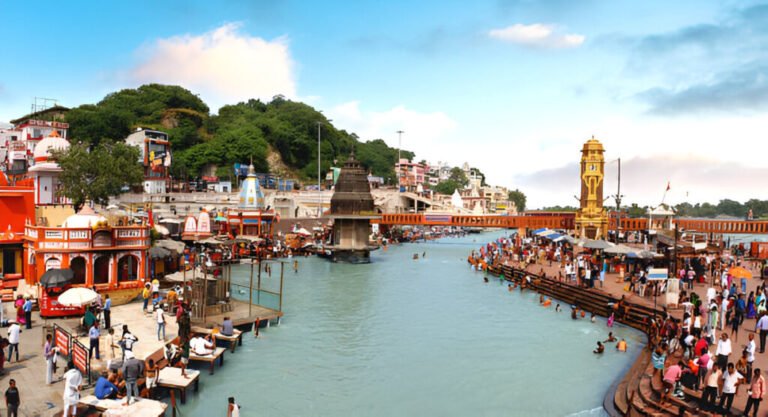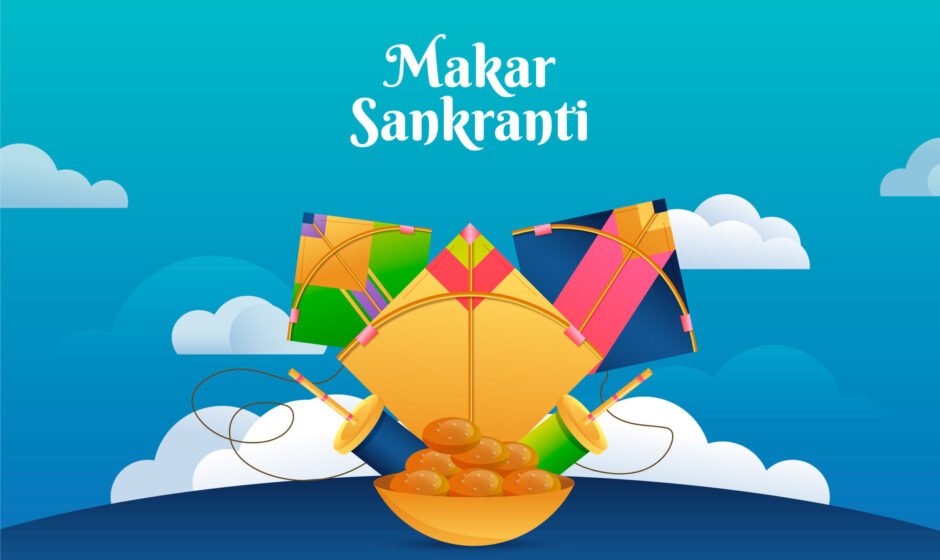🔹 Introduction
The Makarsankranti festival in India is a beautiful blend of spirituality and cultural richness, celebrated in various states, each with its own unique traditions. What makes this festival special is that it’s one of the few Hindu festivals that follows the solar calendar, which means it always takes place on the same date—January 14th or 15th each year.
- 🕰️ Brief History and Significance:
Makarsankranti has its roots in ancient Vedic texts and signifies the sun's shift into Capricorn (Makar Rashi). This transition marks the end of the winter solstice and the start of longer days. It's a celebration of light, knowledge, and the harvest season.
- 🌏 Cultural Importance Across India:
While this celebration goes by various names—Pongal in Tamil Nadu, Uttarayan in Gujarat, Lohri in Punjab, and Magh Bihu in Assam—the core meaning is all about giving thanks, celebrating prosperity, and embracing renewal.
- 🌞 Astronomical Relevance:
This solar transition, known as Sankranti, is seen as a very auspicious time and marks the start of the Uttarayan period, which is thought to be the gods' daylight.
🔹 When is Makarsankranti Celebrated?
Unlike many other Hindu festivals that follow the lunar calendar, Makarsankranti festival in India stands out because it’s celebrated based on the solar calendar. This gives it a set date each year—typically January 14th, though sometimes it falls on the 15th, depending on when the sun makes its transition.
📅 Fixed Date Every Year:
Most often, Makarsankranti falls on January 14th, marking the sun's movement into Capricorn (Makar Rashi). This transition, known as Makarsankranti festival in India, is considered highly auspicious.
🌍 Regional and Astronomical Variations:
In some years and regions, Makarsankranti festival in India may be observed on January 15th—particularly when the Sankranti moment happens late on the 14th. For instance, Makarsankranti 2026 date is expected to fall on January 14th, but exact timings may vary slightly across India due to local sunrise and Sankranti timings.
Paper Kites
🔹 Regional Celebrations Across India
Though known as Makarsankranti festival in India, the celebration takes on different names and customs across various states, each rich in its own cultural flavor. These regional versions reflect India’s diversity while sharing the common theme of harvest, gratitude, and transition into longer days.
🌾 What is Pongal and How is it Celebrated in Tamil Nadu?
Pongal is a major harvest festival celebrated in Tamil Nadu, typically coinciding with the Makarsankranti festival in India. Spanning four days, Pongal is a time for farmers to express gratitude to nature, the Sun God, and cattle for a bountiful harvest. The word “Pongal” literally means “to boil over,” symbolizing abundance and prosperity.
🔹 The Four Days of Pongal Celebrations
1.Bhogi Pongal (Day 1)
Old belongings and waste items are discarded in bonfires.
Homes are cleaned and decorated with kolam (rangoli) made from rice flour.
Marks the beginning of renewal and purification.
2. Thai Pongal (Day 2) – Main Day
The main day of Pongal is dedicated to Surya (Sun God).
Families cook a traditional dish called Sakkarai Pongal, made from freshly harvested rice, milk, and jaggery, in clay pots until it overflows—an auspicious sign.
Offerings are made to the sun, and the event is Makarsankranti festival in India celebrated with prayers, music, and feasting.
3. Mattu Pongal (Day 3)
-
Honors cattle (especially bulls and cows), who play a vital role in agriculture.
-
Cattle are bathed, decorated with garlands and paint, and worshipped.
-
In some regions, bull-taming events like Jallikattu are organized.
4. Kaanum Pongal (Day 4)
- A day for family outings, community visits, and sharing festive food.
- Special prayers are offered to ancestors, and women perform rituals for the well-being of their brothers.
🍛 Traditional Pongal Foods
Sakkarai Pongal – Sweet rice with jaggery, cardamom, and ghee
Ven Pongal – A savory rice-lentil dish
Sugarcane, banana, and coconut are also commonly offered and consumed.

🔥 Meaning and Rituals of Lohri in Punjab
Held on the eve of Makarsankranti festival in India, Lohri involves dancing around a bonfire, singing folk songs, and enjoying foods like rewari, gajak, and peanuts. It celebrates the end of winter and is especially significant for newlyweds and newborns.
🔹 Meaning and Cultural Significance of Lohri
Lohri holds special meaning for farmers, as it signifies a new agricultural cycle and the arrival of longer, warmer days.
The festival also has social and spiritual importance, being associated with new beginnings, such as the birth of a child or a newlywed couple in the family.
Many folk songs sung during Lohri pay tribute to Dulla Bhatti, a legendary Punjabi hero known for rescuing girls from the Mughal army.
🔹 Key Rituals and Celebrations
1. Lighting the Bonfire 🔥
The central ritual of Lohri is gathering around a large bonfire at night.
People throw sesame seeds, popcorn, jaggery, and rewri into the fire as offerings to Agni, the fire god.
2. Singing and Dancing 💃
-
Traditional Punjabi folk songs are sung around the fire.
-
People perform the energetic Bhangra and Gidda dances in groups, often accompanied by dhol beats.
3. Distributing Prasad 🍬
After the bonfire, people distribute and eat festive foods like gajak, rewri, moongfali (peanuts), and til (sesame) sweets.
These foods are also shared with neighbors and guests as a symbol of community bonding.
5. Special Attention to Newlyweds and Newborns 🍼
🌽 Lohri and the Harvest Season
Lohri coincides with the time when sugarcane and other winter crops are ready for harvest. This agricultural context gives the festival its traditional focus on abundance, fertility, and gratitude.

🪁 Complete Guide to Uttarayan and Kite Flying in Gujarat
Uttarayan is Gujarat’s unique and vibrant way of celebrating the Makarsankranti festival in India. It marks the sun’s transition into the northern hemisphere, signifying the arrival of longer days. While the astronomical meaning is pan-Indian, Gujarat transforms this day into a massive, sky-filled celebration of kite flying, food, and festivity.Uttarayan is famous for its amazing kite flying festivals, transforming the skies of Gujarat into a vibrant spectacle. People gather on rooftops, flying kites and savoring delicious snacks like undhiyu and chikki.
🔹 What is Uttarayan?
-
Date: Celebrated every year on January 14th, and the celebrations extend into January 15th, known as Vasi Uttarayan (the second day).
-
Meaning: The word Uttarayan is derived from Uttara (north) and ayana (movement), referring to the sun’s northward journey in the celestial sphere.
🔹 Why is Kite Flying So Important?
Gujaratis believe that flying kites on Makarsankranti festival in India is a way of welcoming the gods back after their six-month-long sleep. Over time, it has evolved into a cultural spectacle, especially in cities like Ahmedabad, Vadodara, Surat, and Rajkot, where people of all ages take to rooftops in celebration.
🔹 Major Attractions of Uttarayan in Gujarat
1. 🪁 Kite Flying from Rooftops
Families gather early morning on their rooftops with piles of colorful kites.
The skies are filled with patang (kites) in various shapes, sizes, and colors.
The friendly cries of “Kai Po Che!” (I’ve cut your kite!) echo all day.
2. 🔗 Kite Fights and Manja (Thread)
People use specially coated strings called manja, traditionally made with glass powder and glue, to cut each other’s kites in aerial battles.
Eco-friendly manja is now promoted to avoid harm to birds and the environment.
3. 🎉 International Kite Festival (IKF) – Ahmedabad
A world-famous event held at Sabarmati Riverfront, where kite flyers from over 40 countries participate.
Showcases giant designer kites, night flying, and cultural performances.


🔹 Traditional Foods Enjoyed on Uttarayan
No celebration in Gujarat is complete without food! Popular delicacies include:
Undhiyu – A mixed vegetable dish slow-cooked in earthen pots
Jalebi – Syrupy, spiral-shaped sweets
Chikki– Crunchy bars made from peanuts and jaggery
Ladoo– Often made from sesame (til) and jaggery

🔹 What to Wear on Uttarayan
Lightweight, colorful traditional outfits are worn for comfort and style.
Women may wear chaniya choli or kurtis, while men often opt for kurta-pajamas or t-shirts with jeans.

🔹 Tips for an Enjoyable & Safe Uttarayan
Wear protective gloves while flying kites to avoid cuts from manja.
Avoid using glass-coated strings to protect birds.
Stay hydrated and apply sunscreen throughout the day.
Bring a Bluetooth speaker for rooftop music and fun.

🎯 Final Thoughts: Why Uttarayan is More Than Just a Festival
Uttarayan isn’t just about kites — it’s about community, joy, and reconnecting with nature. It brings people out of their homes, up to the rooftops, and into the sky — literally and spiritually. Whether you're a first-time visitor or a seasoned flyer, Uttarayan in Gujarat offers an unforgettable cultural experience.
🌞 Makar Sankranti Traditions in Maharashtra and Karnataka
In Maharashtra and Karnataka, Makar Sankranti is celebrated with unique regional customs that blend spiritual rituals, food traditions, and community bonding. Though the festival marks the same astronomical event—the sun’s entry into Capricorn (Makar Rashi)—the way people celebrate it in these states reflects their distinct cultural identities.
🔹 Makar Sankranti in Maharashtra
1. Tilgul Exchange 🍬
The highlight of the festival is exchanging tilgul—sweets made of sesame seeds (til) and jaggery (gul).
While offering tilgul, people say, “Tilgul ghya, god god bola,” meaning “Accept this sweet and speak sweetly.”
This symbolizes forgetting past quarrels and promoting unity.
2. Haldi-Kumkum Ceremony 💛
-
A special gathering of married women, where haldi (turmeric) and kumkum (vermilion) are applied to each other.
-
Women exchange small gifts like bangles, combs, or household items.
-
It’s a ritual to celebrate womanhood, prosperity, and social bonding.
3. Traditional Maharashtrian Attire 👘
Women wear black sarees (usually silk) called Chandrakala or Nauvari, as black is believed to absorb winter sunlight well.

🔹 Makar Sankranti in Karnataka
1.🍥 Ellu-Bella Tradition
People prepare and distribute a mix called Ellu-Bella, made of white sesame seeds, jaggery, coconut, fried gram, and peanuts.
Similar to tilgul in spirit, it’s exchanged with the greeting: “Ellu bella thindu, olle maathadi” (“Eat this mix and speak good words”).
2. 🪔Sankranti Pooja
Homes are cleaned and decorated with rangoli, especially with the sun, sugarcane, and pot motifs.
Families perform pooja to Surya (Sun God) and prepare traditional dishes like Pongal and Vade.
3. 🐄Decorating Cows and Bullocks
Cattle are bathed, decorated with garlands, and worshipped, recognizing their role in agriculture.
In rural areas, bull races or processions are sometimes held.

🎉 Common Themes in Both States
-
Celebrations focus on sweetness, gratitude, and community bonding.
-
Importance is placed on seasonal ingredients like sesame, jaggery, and sugarcane.
-
Homes are decorated with rangoli and filled with festive foods.
🌾 Magh Bihu in Assam – Rituals, Food, and Significance
Magh Bihu, also known as Bhogali Bihu, is Assam’s version of the Makarsankranti festival in India, celebrated with great enthusiasm in mid-January. It marks the end of the harvest season and is a time of feasting (bhog), community gatherings, and honoring the hard work of farmers.
🔹 Rituals of Magh Bihu
1. 🍛Uruka – The Feast Before Bihu
-
Celebrations begin on the night before Magh Bihu, called Uruka.
-
Communities come together to build temporary huts called Meji and Bhelaghar using bamboo, hay, and leaves.
-
A massive community feast is prepared outdoors, with everyone contributing food and firewood.
2. 🔥Bonfire and Meji Burning
-
At dawn on Bihu day, people take a ritual bath and burn the Meji structures, offering rice cakes, betel leaves, and areca nuts to the fire.
-
This act symbolizes the end of winter and evil, and prayers are offered for prosperity and good health.
3. 🙏Worship and Folk Traditions
-
Traditional Bihu songs (called Bihu Geet) and dances are performed.
-
Elders bless the younger generation, and cattle are worshipped for their role in farming, similar to Mattu Pongal in Tamil Nadu.
🍽️ Food of Magh Bihu: A Celebration of Abundance
Magh Bihu is also called Bhogali Bihu because of the lavish food involved. Traditional Assamese dishes reflect the region’s agricultural bounty.
Pitha – Rice cakes made from glutinous rice and jaggery; varieties include Til Pitha, Sunga Pitha, and Tekeli Pitha
Laru – Sweet balls made from coconut, sesame seeds, and jaggery
Fish and Meat Curries – Especially smoked or dried varieties cooked during Uruka
Chira (flattened rice) and Doi (curd) are commonly eaten for breakfast

🌞 Cultural and Agricultural Significance
-
Thanksgiving for a good harvest and invoking blessings for the upcoming planting season
-
Community bonding and strengthening rural ties through shared cooking, music, and prayer
-
A time when young people return home, making it a family-centric festival
🎯 Final Thoughts
Magh Bihu captures the soul of Assamese culture—gratitude, joy, and shared abundance. It’s a powerful reminder of our connection to the earth, our communities, and our traditions. While it shares its astronomical timing with Makarsankranti festival in India, Magh Bihu stands out through its unique food, bonfires, and rural charm.
🔹 Rituals & Customs of Makarsankranti Festival in India
The Makarsankranti festival in India is more than just a celebration of the sun moving into Makar Rashi (Capricorn); it’s a time filled with spiritual reflection, rich cultural traditions, and acts of kindness. Across the nation, people come together to honor this occasion with a variety of heartfelt rituals and customs.
🪁 Kite Flying
In states like Gujarat and Rajasthan, kite flying is the heart of the festival. Rooftops turn into arenas as people compete to cut each other’s kites, shouting “Kai Po Che!”
This tradition symbolizes freedom, joy, and the ascent of good over evil.
kite flying kits, eco-friendly manja (string), and kite-themed decor.
🌊 Holy Dips in Rivers (Ganga Sagar Mela)
Devotees take ritualistic baths in sacred rivers like the Ganga, Yamuna, Godavari, and Krishna.
The most famous is the Ganga Sagar Mela in West Bengal, where millions gather at the confluence of the Ganga and the Bay of Bengal.
These dips are believed to cleanse sins and bring spiritual merit.

🍬 Making Tilgul Laddoos and Sesame Sweets
Sesame (til) and jaggery (gur) are considered warm and nourishing during winter.
Families prepare sweets like tilgul laddoos, chikki, and pongal, which symbolize togetherness and goodwill.
tilgul sweet hampers, DIY laddoo kits, or Indian festive recipe books.
👕 Donating Clothes, Food, and Money
Acts of charity and kindness are encouraged, especially to the poor and needy.
Donating blankets, clothes, grains, or financial aid is believed to bring good karma and spiritual growth.
This ritual highlights the festival's message of sharing prosperity and compassion.

- Kites & kite flying kits
https://amzn.to/4lCc87Q - Pooja items
https://amzn.to/44H7OhU - Traditional sweet-making kits or ingredients
https://amzn.to/3GAK069 - Ethnic wear (kurta sets, sarees, etc.)
https://amzn.to/412ZpTq & https://amzn.to/4nUEvQx
🔹 Makarsankranti Food and Recipes
No celebration of the Makarsankranti festival in India is complete without indulging in traditional dishes that reflect the season’s harvest and regional flavors. From sweet sesame laddoos to hearty rice dishes, food plays a central role in this festival of gratitude and renewal.
🍲 Popular Makarsankranti Recipes Across India
-
Tilgul Laddoos (Maharashtra)
Made from sesame seeds (til) and jaggery (gul), these are symbolic of warmth, sweetness, and unity.
👉 “Tilgul ghya, god god bola!” is the iconic greeting while sharing them. -
Pongal (Tamil Nadu)
A comforting South Indian rice and lentil dish, cooked with ghee, black pepper, and cumin. The sweet version (Sakkarai Pongal) includes jaggery and nuts. -
Puran Poli (Maharashtra & Karnataka)
A festive flatbread stuffed with a sweet mixture of chana dal and jaggery, served with ghee. -
Ellu Bella (Karnataka)
A dry mix of white sesame seeds, jaggery, roasted peanuts, fried gram, and coconut—shared as a token of peace and goodwill. -
Chikki (North India & Gujarat)
Crunchy sweet bars made of peanuts and jaggery, perfect as a winter snack. -
Ladoo (Til Ladoo, Dry Fruit Ladoo, etc.)
Energy-packed and nutritious, these are prepared in different regions with local ingredients like fox nuts, dates, and dry coconut.
🛒 Shopping Ideas:
 Recipe Books
Recipe Books
“Indian Festival Foods: Authentic Recipes from Every State”
“Sweets of India: A Cultural Culinary Guide”
 Food Ingredients
Food Ingredients
Organic white sesame seeds
Pure jaggery blocks or powder
Premium quality ghee (cow or A2)
Moong dal, chana dal, rice, cardamom
 Kitchen Tools & Essentials
Kitchen Tools & Essentials
Non-stick pans for laddoos and chikki
Steel ladles and tongs for stirring jaggery
Traditional molds or laddoo shapers
🔹 What to Wear on Makarsankranti
The Makarsankranti festival in India is not only about food, kites, and rituals—it’s also a time when people dress up in vibrant, traditional attire. Clothing choices often reflect regional customs, weather, and the cultural spirit of the festival.
👗 Traditional Clothing by Region
Maharashtra:
Women wear black sarees (typically silk) with golden borders, as black absorbs warmth during the winter chill. Men wear kurta-pajama or dhoti-kurta.Punjab (Lohri):
Women dress in bright phulkari suits, while men wear kurta-pajama with pagdi (turban) and jutti.Tamil Nadu (Pongal):
Women wear Pattu sarees (silk sarees), and men dress in veshti (white dhoti) and angavastram.Gujarat (Uttarayan):
Men and women opt for comfortable cotton kurtas, Patiala pants, or lehengas—ideal for all-day kite flying.Assam (Magh Bihu):
Traditional mekhela chador for women and dhoti-kurta for men are popular, often in woven silk and cotton.
👨👩👧👦 Clothing Recommendations by Gender & Age
Men:
Light cotton or silk kurta-pajamas, Nehru jackets, or ethnic dhotis for a traditional look.Women:
Sarees, salwar suits, lehengas, or festive kurtis with dupattas. Consider black or bright warm tones like maroon, mustard, or emerald.Kids:
Festive kurta sets, ethnic frocks, or dhoti-kurta combos are both comfortable and cute.Elderly:
Soft, warm traditional wear with minimal jewelry—think handloom sarees or woolen shawls over ethnic suits.
🛍️ Shopping Ideas: Fashion & Accessories
👚 Ethnic Wear: Sarees, lehengas, kurtas, Nehru jackets, kids' ethnic sets
💎 Jewelry: Oxidized earrings, bangles, mangalsutra sets, and pendants
🧣 Accessories: Potlis, mojris, dupattas, embroidered clutches
🧥 Winter Add-ons: Shawls, stoles, thermals under ethnic outfits
🔹 Gifts & Decor Ideas for Makarsankranti
Makarsankranti festival in India is more than just rituals and delicious food—it’s a wonderful opportunity to share joy through thoughtful gifts and charming home decorations. Whether you’re throwing a festive get-together or sending warm wishes from a distance, giving gifts and sprucing up your home truly captures the spirit of the season.
🎁 Gift Hampers for Relatives & Kids
- Tilgul Gift Boxes – Sweet boxes filled with tilgul laddoos, chikki, and sesame treats
https://amzn.to/3TRZ1mV - Pongal Hampers – Include rice, jaggery, ghee, turmeric, and decorative items
https://amzn.to/45eCIOF - Kids’ Festive Packs – Traditional sweets, chocolate, kites, and ethnic outfits
https://amzn.to/3IDuUgz - Spiritual Gift Sets – Brass idols, incense sticks, pooja kits, and devotional books
https://amzn.to/3Un3K03

🏡 Home Decor Items to Celebrate in Style
Rangoli Kits – Pre-designed stencils, rangoli powders, and eco-friendly options
Torans & Bandhanwars – Traditional hangings for doors made of fabric, beads, or artificial flowers
Diyas & Lamps – Brass, clay, or LED diyas for morning and evening poojas
Wall Hangings – Sun-themed or harvest-style festive décor

“Festive Home Makeover” store
“Ethnic Home Decor” collection
Artisanal stores for handmade torans or diya sets
✉️ Bonus: Custom Greeting Cards & Printables
Send digital greeting cards for Makarsankranti with personalized messages.
Offer free printable rangoli designs or coloring pages for kids as lead magnets or downloadable bonuses.
🔹 Eco-Friendly Celebrations for Makarsankranti
While the Makarsankranti festival in India is a time of joy and tradition, it’s equally important to celebrate it responsibly. Adopting eco-friendly practices ensures that our rituals don’t harm nature, birds, or the environment.
🌱 Sustainable Ideas for a Green Makarsankranti
Promote Sustainable Kite-Making
Choose handmade paper kites or those made from biodegradable materials.
Avoid foil or plastic kites, which cause pollution and pose threats to wildlife.
Encourage local artisans by buying from them instead of mass-produced imports.
Say No to Plastic/Glass-Coated Manja
Avoid synthetic or glass-coated threads (Chinese manja), which are dangerous for birds and humans.
Instead, use cotton threads or eco-safe manja coated with natural materials like rice paste or plant resin.
Use Eco-Friendly Decorations
Decorate with cloth torans, natural flowers, and hand-painted diyas.
Opt for organic rangoli colors instead of chemical-laden powders.
Gift Sustainably
Choose organic hampers, handmade goods, and zero-waste packaging.
Wrap gifts using recycled paper or reusable cloth instead of shiny plastic wraps.
🛍️Shopping Ideas: Green Products for Makarsankranti
-
✅ Eco-friendly kite kits
-
✅ Natural manja spools
-
✅ Organic rangoli powders
-
✅ Handmade diyas & torans
-
✅ Sustainable gift wraps & cloth bags
🔹 Makarsankranti Quotes, Wishes & Social Media Captions
Makarsankranti festivals in India are all about sharing joy—and in today’s digital world, that means sharing warm wishes and festive vibes on WhatsApp, Instagram, Facebook, and beyond. These Makarsankranti wishes and Instagram captions are perfect for personal messages or to engage your blog/social media audience.
💬 Ready-to-Copy Makarsankranti Wishes
-
✨ Wishing you a harvest of happiness and a sky full of colorful kites! Happy Makar Sankranti!
-
🌞 May the sun radiate peace, prosperity, and positivity in your life. Happy Makarsankranti!
-
🪁 Fly high like the kites this Sankranti. May your success soar as high as the sky!
-
💫 Let’s welcome the new season with hope, joy, and tilgul! Happy Makar Sankranti!
-
🌾 May your life be filled with sweet moments just like sesame and jaggery laddoos.
📸 Makarsankranti Captions for Instagram & Social Media
-
🪁 Kai Po Che! Flying high into 2026 with colors and joy. #MakarsankrantiVibes
-
🍬 Tilgul ghya, god god bola 💛 #SweetBeginnings #FestivalSeason
-
🌞 New sunshine, new energy, and a sky full of dreams. #HappyMakarSankranti
-
✨ Celebrating traditions, food, and family under the open sky. #SankrantiFeels
-
🎉 Kites, sweets, and love all around! #Makarsankranti2025 #KiteFestival
Table of Contents
🔹 Final Thoughts
The Makarsankranti festival in India is more than just a change in the solar calendar—it's a celebration of harvest, hope, unity, and renewal. Whether it’s flying kites in Gujarat, cooking Pongal in Tamil Nadu, or exchanging tilgul in Maharashtra, every region adds its own vibrant thread to this beautiful cultural fabric.
✨ Celebrate this Makarsankranti with warmth in your heart, sweetness on your plate, and gratitude in your soul.
🛍️ Exclusive Festive Deals – Shop the Sankranti Spirit!








What is Makarsankranti and why is it celebrated?
Makarsankranti marks the sun’s transition into the zodiac sign of Capricorn (Makar Rashi). It is celebrated as a harvest festival across India to honor the end of winter and welcome longer, warmer days. It symbolizes prosperity, new beginnings, and gratitude for a good harvest.
When is Makarsankranti celebrated each year?
Makarsankranti is usually celebrated on January 14th or 15th every year. The exact date may vary slightly based on the solar calendar and regional customs.
What are the main rituals of Makarsankranti?
Popular rituals include kite flying, taking holy dips in sacred rivers like the Ganges, preparing and sharing sweets made from sesame and jaggery (tilgul laddoos), and donating food or clothes to those in need.
How do different regions in India celebrate Makarsankranti?
Different regions have unique celebrations such as Pongal in Tamil Nadu, Lohri in Punjab, Uttarayan in Gujarat, Magh Bihu in Assam, and the traditional Makar Sankranti festivities in Maharashtra and Karnataka.
What foods are traditionally prepared during Makarsankranti?
Common festive foods include tilgul laddoos, pongal, puran poli, chikki, and other sweets made with sesame seeds, jaggery, and ghee that symbolize warmth and togetherness.
Is Makarsankranti celebrated on a fixed date every year?
Yes, unlike many Indian festivals based on the lunar calendar, Makarsankranti is celebrated on a fixed solar date around January 14th or 15th annually.
How can I celebrate Makarsankranti in an eco-friendly way?
Opt for biodegradable kites, avoid plastic or glass-coated kite strings (manja), use natural rangoli colors, and choose organic or handmade decorations and gifts to reduce environmental impact.
What is the significance of kite flying during Makarsankranti?
Kite flying represents joy, freedom, and the victory of light over darkness. It is especially popular in Gujarat and Rajasthan, where people gather in large numbers to compete and celebrate the festival.
Can I send Makarsankranti gifts online?
Absolutely! Many e-commerce platforms like Amazon, Flipkart, and specialized gifting websites offer festive gift hampers, sweets, and decor items perfect for sending warm wishes during Makarsankranti.



